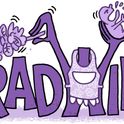My colleague was struggling with a logical conundrum and didn?t want to be outwitted by her gloating partner. Out of desperation, she emailed the entire department in search of a solution. I looked at the puzzle but couldn?t solve it, so carried on with what I was meant to be doing. I didn?t think about it for the rest of the day. But later, as I lay in bed, I rehearsed the scenario: ?You are alone in a room with three light switches. Downstairs there is a room with three lightbulbs, all initially off, but each connected and working. You can?t see these bulbs, or any light they cast when you flick a switch, but you need to find out which switch operates which light. You may only go downstairs once. How do you do it??
I drew mental diagrams, tried verbal logic, and projected an image of myself into a stark white room to stare at three switches on a wall. I coloured them red, blue and yellow for clarification, coding the bulbs likewise. And then I gave up. Rational thought and imagery gave way to a hypnogogic theatre of the absurd and Mr Padfield the Puzzle Man lumbered into the spotlight. He wanted to fight. He didn?t like the look of me. I remembered what the nurse had said about keeping him away from puzzle books. She had found it necessary to ban them from the day room for the duration of Mr Padfield?s stay. But giving patients puzzles was part of my job. I?d miscalculated, and now there was coffee running down the wall and the bright red and white cubes of the Block Design test were all over the place. ?I?ve had enough of this and I?ve had enough of you,? he growled, an inch from my face.
In the famous ?four F?s? catalogue of motivational states, ?fight? is adjacent to ?flee,? some way down the line from ?feed? and ?fuck.? They reverberate, for the most part, through the same brain pathways. Thus my nervous system resonated with Mr Padfield?s neuronal machinery across frontal lobe, amygdala and hypothalamic networks right to the crucial junction where fight and flight diverge, at which point the flow of my nerve impulses followed the channel marked ?exit.? Our hearts were racing, our foreheads were glazed, but his hands were hot with anger while mine were cold with fear. The signs were clear. His fists clenched. I wasn?t about to be eaten or fucked.
Mr Padfield himself was a puzzle. I used to present him as such to my students. Pathological anger, from irascibility to rage, are typically linked with damage to subregions of the frontal lobes but this man?s problem was a haemorrhage in the cerebellum, the brain?s hindmost structure. I?d describe his behaviour, then have the students guess the site of the lesion. There was never any mention of the cerebellum. Go away and think about it, I?d tell them, see if you can figure it out. In fact, Mr Padfield was not so difficult to solve. Although geographically distant, the cerebellum and frontal lobes are connected in various ways. Metabolic changes in one region quickly seep into the other. This can be demonstrated by drinking alcohol. Slurred speech and social disinhibition, indicating impaired cerebellar and frontal functions, are among the earliest signs of intoxication. It is also no mystery that these two brain regions are especially vulnerable to long-term alcohol-related damage.
But why the fatal attraction to puzzles in Mr Padfield?s case? In modest doses, anger, like alcohol, can be a good thing. It sparks goal-directed action and sustains motivation. To be in problem-solving mode is to be in a state of benign irritation. Determination can be thought of as a kind of low-level, constructive anger. Mr Padfield?s stroke had left him flat and indifferent to the world. It was hard for him to get going most of the time, but a good brainteaser served as an ignition key. His engine would turn and he?d chug along. He was energised by puzzles and solving them put a spring in his step. Failing to solve them, on the other hand, turned benign irritation into blind rage.
Back in the antechamber of sleep he was about to thump me, but I had something up my sleeve: Mr Padfield, imagine this. You are alone in a room with three light switches? He stopped dead, brows stitched in perplexity now rather than rage. He grunted, and left the room. I pictured him trudging off to some other, unconscious brain zone to wrestle with the conundrum. It didn?t happen that way in reality, of course. In reality, I was the one with my eye on the door.
When the radio clicked on at 6.30 I was already wide awake. The solution to the puzzle hovered before me fully formed. I was annoyed with myself for not having seen it straight away. How dim of me, I thought. It?s so obvious. Why hadn?t I seen it yesterday? And how could I now claim credit for getting there when I (the conscious, rational, observing ?I? that had failed so dismally) had played no part in the achievement?
A few months after we discharged the Puzzle Man my nurse colleague was standing in a supermarket checkout line. Ahead of her a woman was trying to pay for a loaf of bread with a credit card. A loud ?Christalmighty!? came from the back of the queue and she turned to see a familiar red-faced man with a white-knuckled grip on his shopping trolley. It wasn?t just puzzles, unfortunately.












